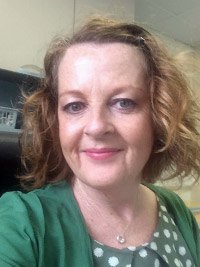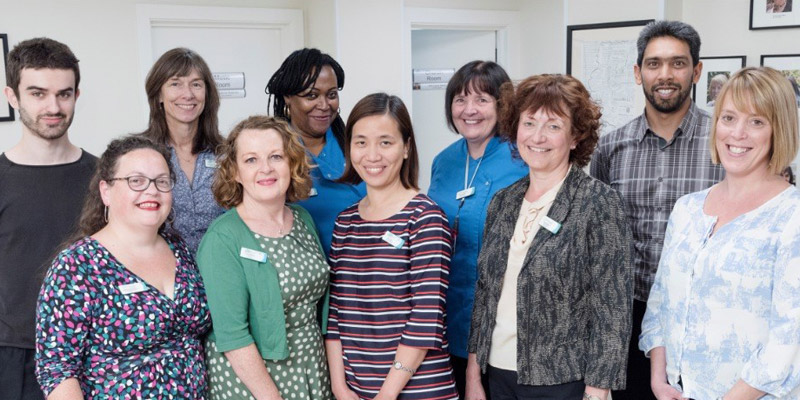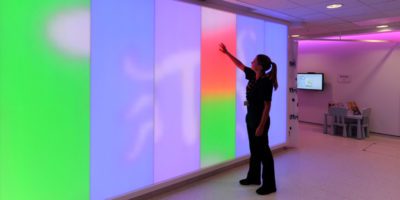Julie Belton is strategic and operations director at Cuckoo Lane Surgery in Hanwell, London and a director of the Ealing GP Federation. Julie has extensive experience in primary care working as a nurse practitioner and she spent 11 years working in quality clinical governance and practice development, improving service provision for patients and public. The Cuckoo Lane practice is slightly different to other practices, not being run by a partnership of doctors – instead they are run by Julie and her colleague Carol Sears (pictured above, front row – second from the right), so their doctors are free to see and treat the most complex patients without the extra jobs of staff management and training etc.

“…Be maverick … Don’t compromise on quality in any way…”
From nurse to director
I trained as a nurse as I’d always had an interest in healthcare and science. I was always a caring individual as a child and I was always interested in the welfare of others, so I trained as a registered nurse and then I trained as a midwife. I then went into general practice and did the first nurse practitioner course that was held in the UK, led by somebody called Barbara Stilwell, and then I mentored other nurse practitioners.
I worked in practice for a bit before deciding that I’d move into a quality and practice development role where I was a nurse adviser for practices across Southall and West Ealing PCG (Primary Care Group). I then went into the role of practice development, quality and clinical governance for about ten years.
How Cuckoo Lane was set up
My colleague, Carol Sears, who I work now alongside, worked in a GP’s practice ten years ago where the GP retired and the practice went out to tender. She and two other members of staff (a practice nurse and a practice manager) put a bid forward and were successful against about 12 other bids.
That ran, but the practice manager left relatively quickly afterwards and so my colleague who I still work with – Carol – and the practice nurse ran the practice. About four years ago the practice nurse director retired from her position, so I was approached to be a director here, and I’ve been here ever since. I am a clinical nurse practitioner. I am a prescriber, but I also strategically and operationally move the practice forward.
A new model of practice with patients at the centre
The model is different. We’ve tried to adopt quite a flat structure of leadership. We have a mutual participation model with patients so they’re at the centre and they can make decisions about their own care, as much as that it absolutely possible.
Having a flat structure means it’s not hierarchical, and there’s lots of teamwork. We do quite a few things differently and one of the things that was highlighted in the recent outstanding CQC [Care Quality Commission] report was communication and leadership. We are a practice that communicates – we have a twice daily huddle for all members of staff – a briefing about what’s going on that day.
What the staff and patients say
We gather information about what patients think of our service. Almost 100% of patients agree that they would recommend us to their friends and family. We run research every month and we display the outcome of that on our notice boards – we laminate it and we put it up with a graph, along with any comments that come from patients – positive or negative. There’s not a lot of negatives, but we do share those too.
Some things patients have said:
“The staff have always been always been exemplary.”
“Doctors, nurses and reception are helpful.”
“They’ve improved customer relationships.”
“They’re willing to fit in appointments.”
“I’m made to feel like a person”
Our statement and purpose is all about being committed to patient needs – being courteous, approachable and friendly. We work with patients to keep them healthy in their own homes.
The staff perspective:
“Flat structure leads to good working relationships.”
“The main reason for the model working is communication – we talk to each other all the time.”
“Directors provide training to increase knowledge and skills.”
“It’s not about the money – you’re rewarded in other ways. Birthday and other treats make me feel valued and appreciated.”
“I’ve got job satisfaction.”
We’re mostly women as the moment but we’re getting more men joining us. We have two male apprentices and we’ve got a male receptionist. We’ve got one female GP and two male GPs.
Using doctors’ expertise in a different way
Potentially this model could be emulated elsewhere.
It’s quite nice for doctors to be able to go to work and just do the medical stuff – so using their expertise in a different way. Lots of contracts are for patients being seen outside of hospital. More and more complex things are being managed in general practice and it’s about having the appropriate skills mix of appropriate staff to see patients.
Advice to other nurses who might be considering developing practices in the same way
Be maverick. The key is good communication – developing your workforce, valuing your workforce, investing in your workforce. Make sure you’re communicating with them and make sure you’ve got really good systems and processes in place where quality is at the centre. Don’t compromise on quality in any way.
I did a Master’s in Individual and Organisational Development at Westminster. I’ve also undertaken numerous leadership courses.
We’re continually learning. We’ve all undertaken coaching training, so it’s about coaching staff and coaching patients – putting them at the centre of all decision making.
The future for Cuckoo Lane
It’s about continuous improvement and potentially investigating whether the model could be emulated elsewhere, as in its current form. This model has been successful here – could we use some of the systems and processes to mirror that in another setting.
http://cuckoolanesurgery.co.uk/
https://twitter.com/14cuckoolane
https://www.facebook.com/The-Cuckoo-Lane-Practice





